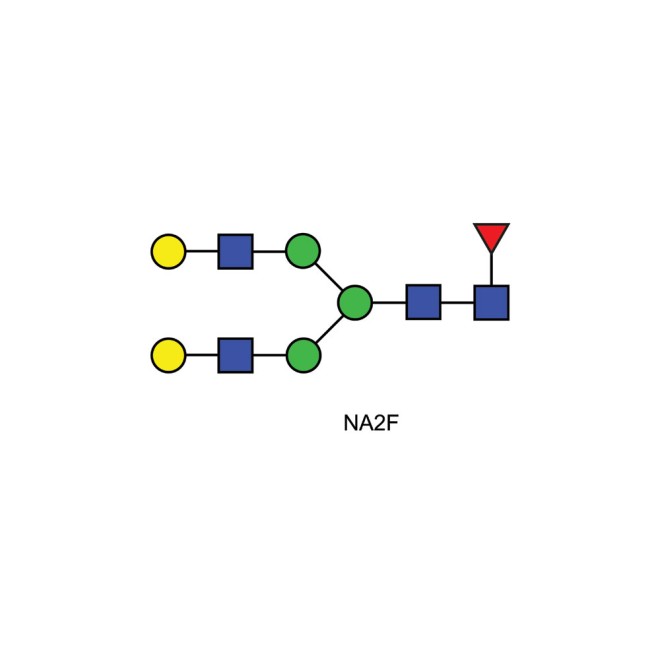NA2F glycan (FA2G2, G2F)
Biantennary N-glycan that contains terminal galactose residues and fucosylation on the core GlcNAc. size:20µg m/z: 1786.6501
NA2F glycan is found on several mammalian glycoproteins including IgG, gamma globulins, and many serum glycoproteins. This product is typically purified from the oligosaccharide pool released from porcine thryroglobulin by hydrazinolysis using a combination of HPLC and glycosidase digestion.
Product Specification
NA2F Glycan Synonyms: NA2F N-linked oligosaccharide, FA2G2, F(6)A2G2, G2F
Description: Asialo-, bi-antennary complex-type N-glycan (oligosaccharide). NA2F is the asialo-substructure of A2F glycan.
Molecular Weight: 1787
Purity: > 90% pure as assessed by a combination of 1 H-NMR and HPLC.
Sources: NA2F glycan is found on several mammalian glycoproteins including IgG, gamma globulins, and many serum glycoproteins. This product is typically purified from the oligosaccharide pool released from porcine thryroglobulin by hydrazinolysis using a combination of HPLC and glycosidase digestion.
Form: Dry. Dried by centrifugal evaporation from an aqueous solution.
Storage: -20˚C both before and after dissolution. This product is stable for at least 5 years as supplied.
Shipping: The product can be shipped at ambient when dry. After dissolution, ship on dry ice.
Handling: Allow the unopened vial to reach ambient temperature and tap unopened on a solid surface to ensure that most of the lyophilized material is at the bottom of the vial. Gently remove the cap, add the desired volume of reconstitution medium, re-cap and mix thoroughly to bring all the oligosaccharide into solution. For maximal recovery of oligosaccharide, ensure that the cap lining is also rinsed and centrifuge the reconstituted vial briefly before use. Ensure that any glass, plasticware or solvents used are free of glycosidases and environmental carbohydrates. Minimise exposure to elevated temperatures or extremes of pH. High temperatures and low pH will cause desialylation. High pH will cause epimerisation of the reducing terminus GlcNAc.
Safety: This product is non-hazardous and has been purified from natural sources certified to be free of all hazardous material including pathogenic biological agents.
Safety: This product is non-hazardous and has been purified from natural sources certified to be free of all hazardous material including pathogenic biological agents.
HPLC Analysis of Glycans
LudgerPure unlabeled glycans and LudgerTag labeled glycans may be separated and analysed by a variety of HPLC (high pressure liquid chromatography) methods using LudgerSep™ HPLC columns.
The LudgerSep columns are are available for the following applications:
Separation of charged and neutral glycans via anion exchange columns:
LS-C3-7.5×75 LudgerSep C3 – 7.5x75mm
LS-C2-4.6×50 LudgerSep C2 – 4.6x50mm
Profile analysis of neutral and charged glycans via normal phase columns:
LS-N2-2.0×250 LudgerSep N2 – 2.00x250mm
LS-N2-4.6×250 LudgerSep N2 – 4.6x250mm
LS-N1-4.6×250 LudgerSep N1
The LudgerSep N2 columns are an especially powerful tool for the purification and analysis of LudgerTag labeled oligosaccharides from complex glycan mixtures. Please contact us for advise regarding your particular application.
Mass Spectrometry and Electrophoresis
LudgerPure and LudgerTag labeled glycans may also be analysed by mass spectrometry, electrophoresis, and various types of spectroscopy. Please call us for advice on the dyes and analysis conditions most suitable for your intended analyses.



-660x660.jpg)
